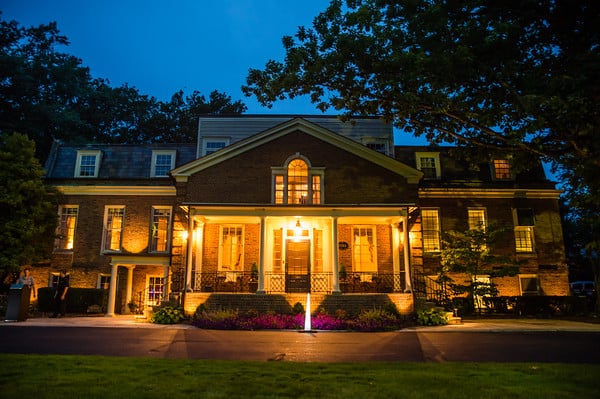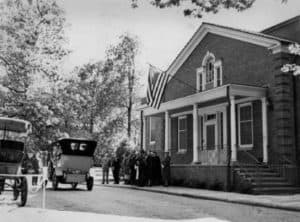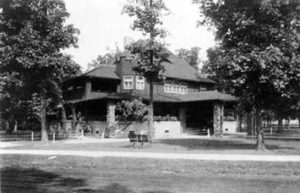About The Clifton Club
 The Clifton Club is a premier dining and social club located on America’s North Coast in Lakewood, Ohio, a western suburb of Cleveland.
The Clifton Club is a premier dining and social club located on America’s North Coast in Lakewood, Ohio, a western suburb of Cleveland.
Established in 1902, The Clifton Club has been one of the most pleasant places to visit and spend time on the shores of Lake Erie, providing a quiet and relaxing experience with the convenience of being close to the Greater Cleveland area.
Today the Club offers its members best-in-class service from a dedicated staff, mouthwatering food prepared by a highly trained and experience chef, and all this provided in a beautiful historical building situated 90 feet above Lake Erie at the mouth of the Rocky River.
Our 3-story clubhouse provides a haven for its members and their guests. It is a place to meet, socialize, and enjoy fine food and impeccable service. The clubhouse is composed of formal and informal dining rooms and lounges, a private dining room, a pub, as well as a terrace overlooking our beautiful patio and manicured gardens. The Clifton Club is truly a rare gem and a treasure of Lakewood, Cleveland and all of Northeast, Ohio.
Club Directors & Staff
2024-2025 Board of Directors
Michael Hamed, President
Bill Barmann, Vice President
Andrea Burgess Atkins, Treasurer
Brent Tuma, Secretary
Michael Fruchey, Membership
Donna Klein, Social
Stephen Kisan
Kelly Dillon
John Burke, Legal
Hugh O’Donnell, President Ex Officio
Robert Stall, CP Advisor
Club Management
Kathleen M. Stringer, General Manager
Debi Kula, Accounting/Office Manager
Ramell Carter, Executive Chef
Annie Swartz, Director of Catering & Membership
Debra White, FOH Manager
Clifton Club History
 The year 1903 was significant for many reasons, not the least of which was that The Clifton Club first opened its doors on August 22nd.
The year 1903 was significant for many reasons, not the least of which was that The Clifton Club first opened its doors on August 22nd.
The automobile, still a novelty, was coming of age. The first auto trip from San Francisco to New York was completed on August 1st, in a car made by our own Alexander Winton.
Henry Ford that year brought out his first production car, the original Model A, with the slogan “Absolutely no Smell, Noise or Jolt.” A CLEVELAND PRESS headline on August 22nd, the day of the Clifton Club opening, read “Rockefeller Buys a Chu-Chu Wagon”; Cleveland’s first citizen had purchased his first automobile and planned to buy two more for use about the grounds of his Forest Hills estate.
The Wright brothers were preparing to risk the first heavier-than-air flight, which Orville was to accomplish on December 17th of that year. Theodore Roosevelt was in the White House and in January of 1903 had signed a treaty with Colombia agreeing to the construction of the Panama Canal. The treaty was rejected by Colombia, resulting in the secession of Panama from Colombia and Panama’s recognition by T.R. on November 6th.
In Lakewood during the week of the Club’s opening, building lots on Alameda Avenue were being promoted with advertisements stating that “the location and the size of the lots make this the most desirable spot in Greater Cleveland.” The Clifton Park Land and Improvement Company, in a CLEVELAND LEADER ad August 16th, used the “about to open” Clifton Club as an attractive feature in their campaign to sell lots in Clifton Park:
“The new Clifton clubhouse will he formally opened next Saturday. This (Clifton Park) most beautiful of all suburban property near Cleveland is rapidly filling up with fine homes. It is but seven miles from the Public Square and is reached in thirty minutes time via the Boulevard Electric cars. There are beautiful drives, wooded lots, lake and river, bathing and boating, pure air and no dirt at Clifton Park. There is every convenience of the city – there are all the delights and comforts of the country.”
That August week in 1903 Halle Brothers advertised in the CLEVELAND PRESS: “Natural Mink Four-Pelt Scarves – $18.00,” and “Eight-Skin Chinchilla Scarves – $29.00”. The Bailey Company offered Men’s Fine Kuppenheimer Suits – $14.75! That was the world that was. The CLEVELAND LEADER Sunday, August 16th, 1903 announced that the formal opening of the clubhouse would be held the following Saturday, and described the new building as follows:
 “The clubhouse is a delightful building, of pleasing appearance. The exterior is of the rambling country club design, quiet in color and low in roof. The masonry is gray brick trimmed with cobblestones. The first story walls are of gray plasterwork, trimmed with wide, simple ribs of brown woodwork. The second story exterior is of dark red shingles with brown trimmings and the roof is the same. The window sashes are all in white.”
“The clubhouse is a delightful building, of pleasing appearance. The exterior is of the rambling country club design, quiet in color and low in roof. The masonry is gray brick trimmed with cobblestones. The first story walls are of gray plasterwork, trimmed with wide, simple ribs of brown woodwork. The second story exterior is of dark red shingles with brown trimmings and the roof is the same. The window sashes are all in white.”
“The porches are a feature, being very broad and are made massive by means of masonry walls instead of the ordinary spindle variety. The porch furniture is in keeping with the idea of making the porches the feature of summer club life. The building is situated near the top of the hill, com-manding a magnificent view of the mouth of Rocky River, and, of course, of the lake beyond. with the picturesque river valley to the south.”
“The first floor interior is composed of a large reception hail with massive beam ceilings and cobblestone fireplace, with stone mantel shell. Opening from it is the gentlemen’s room, a large apartment used jointly as a billiard and smoking room. In the rear of the reception hall is the office and telephone booths, and beyond them the large dining hail, off of which two private dining rooms and the grill room open. There is also a side entrance for nurses and children behind the dining hall, and in the rear are the servants dining room and the kitchens and pantries.”
“The prevailing tone of the woodwork in the reception hall is dark olive green, whereas the woodwork in the dining rooms is in ivory enamel. The floors are hardwood and are varnished. The furniture of the hail and billiard room is of Flemish oak in the mission style, while the furniture in the dining halls is of mahogany.”
“A main central corridor divides the second floor. On one side is the ballroom and across the way are five private chambers with accompanying bathrooms. The ballroom, like the dining halls, is in ivory enamel, with an elaborate mantelpiece. The trusses are handsomely ornamented, and the wall decorations are rich cerise pink wallpaper with silk background, and the walls and ceiling above the paper are elaborately finished in cerise pink, gold and ivory. Jib the west of the main ballroom is a large second story balcony with canvas floor for the use of dancers. The third story contains five smaller chambers for the use of summer guests.”
Describing the opening reception on the twenty-second, the CLEVELAND LEADER for Sunday, August 23, said:
“Yesterday the hospitable doors of the new clubhouse were thrown open to friends and between the hours of 3 and 10 p.m. nearly three hundred persons were present. An orchestra played sweetly all the afternoon in the handsome. dark-raftered reception room, and in the beautiful dining rooms punch was served from 3 to 6 o’clock, and at 6 o’clock a delicious buffet supper.”
“In the evening Rosenthal’s orchestra played for dancing in the ballroom on the second floor. – – The floor was like glass, and the young people enjoyed the dancing greatly.”
The club’s charter is dated May 28, 1902, but before that plans had already been well formulated. The PLAIN DEALER for Sunday, April 6, 1902 carried a brief story under the headline “New clubhouse For West Side”, including what purported to be an architect’s drawing of a building about three times as large and elaborate as the actual clubhouse that was to be completed sixteen months later.
The land on which the club stands was leased on July 1st, 1902 from “The Clifton Park Land Company, a corporation, by R.E. Burdick, President”. The rent on the twenty-year lease was $1.00 annually. There was also an option to purchase for $14,000, and the lease contained the following sentence: “Nor shall liquor whether spirituous, vinous, or fermented be sold either at wholesale or retail on said premises.” The Clifton Club officially opened its doors on August 22, 1903 to nearly 300 guests. The event featured an orchestra, punch, and a delicious buffet supper.
Clifton Park History
Clifton Park, a big diamond in Lakewood’s tiara, had its beginnings in 1866 when a group of nine men envisioned a large-scale summer resort at the mouth of the Rocky River.
They were real estate developers Elias Sims, John H. Sargent, Thomas Dixon, Josiah Barber and Ezra Nicholson; coal operator Daniel P. Rhodes; lake captains George W. Jones and John Spaulding, and banker and surveyor George E. Hartnell.
In 1869, they signed articles of incorporation for the Clifton Park Association. Soon, attractive picnic groves, beer gardens, clean bathing and a scramble of boating activity drew great numbers of summer fun seekers from Cleveland. Many came via the single-track Rocky River Railroad created as part of the promotion package.
By 1874, attention turned to Clifton Park as a residential community, and subdivision of about 80 lots was formed there. The first home was that of William J. Starkweather at 17866 Lake Road. It has 19 large rooms, seven fireplaces and mahogany woodwork throughout. William died there in 1899, and the home was razed in 1969.
Many of the older homes were summer places, according to Clifton Park chronicler Blythe Gehring of Lakewood. Most were designed to be operated by servants and had special quarters to accommodate them.
Just before the turn of the century, a bathhouse was built on Clifton Beach for park residents. It burned to the ground in the winter of 1956.
A wooden building that stood near the bathhouse was the home of the Lakewood Yacht Club, organized in 1900. T.R. Morgan was elected first commodore in March of that year.
The Clifton Club was incorporated as a social organization in Clifton Park in May 1902. Its site at 17884 Lake Road was leased from the Clifton Park Association at $1 a year for 14 years and then purchased outright by the club.
One Sunday morning in January 1942, the club, like the old bathhouse, was destroyed by fire. In 1950, the current club building was put up on the same site as the original.
Learn more about Clifton Park at the links below!
The Clifton Club Fire – January 11th, 1942
 These were the headlines in the PLAIN DEALER on January 12th, 1942: Early in the bitterly cold morning of January 11th, 1942, the clubhouse, in its thirty-ninth year of useful, gracious life, caught fire and burned to the ground.
These were the headlines in the PLAIN DEALER on January 12th, 1942: Early in the bitterly cold morning of January 11th, 1942, the clubhouse, in its thirty-ninth year of useful, gracious life, caught fire and burned to the ground.
The fire took place exactly five weeks after the attack on Pearl Harbor and America’s declaration of war against Japan and Germany. Under wartime restric-tions covering building materials and manpower there was no possible chance that the build-ing could he rebuilt at that time or for several years after. For nearly eight years the club membership was held together tenuously, with only the beach facilities to offer.
 Eventually the officers and direct-ors, after rejecting at least two more costly designs by other architects, adopted plans for a new building prepared by Charles Bacon Rowley and Associates. On June 3rd, 1950, less than nine months after the construction contract was signed, the new clubhouse was completed with no outside debt being incurred. Robert C. Sessions was the club president during the construction year and the year following.
Eventually the officers and direct-ors, after rejecting at least two more costly designs by other architects, adopted plans for a new building prepared by Charles Bacon Rowley and Associates. On June 3rd, 1950, less than nine months after the construction contract was signed, the new clubhouse was completed with no outside debt being incurred. Robert C. Sessions was the club president during the construction year and the year following.
This has been largely a history of bricks and mortar, nuts and bolts – all undeniably important. But there has been another element over the year a more important one: the spirit of the Clifton Club, the spirit which guided the founders of the Club, the builders of the clubhouse, the directors and officers who have managed its affairs, and the members who have supported and used and enjoyed the Club through the years.
 No records have been kept of the many receptions the two houses have seen, the family parties and celebration, or how many affairs held simply for enjoyment. It is out of these moments and the desire to maintain a special place to weave them that the club exists and has a spirit of its own. And it will survive as long as the members continue to use and support and enjoy The Clifton Club, as they do ever-new moments to a place already dearly rich with history.
No records have been kept of the many receptions the two houses have seen, the family parties and celebration, or how many affairs held simply for enjoyment. It is out of these moments and the desire to maintain a special place to weave them that the club exists and has a spirit of its own. And it will survive as long as the members continue to use and support and enjoy The Clifton Club, as they do ever-new moments to a place already dearly rich with history.
